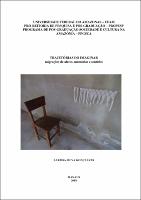| ???jsp.display-item.social.title??? |


|
Please use this identifier to cite or link to this item:
https://tede.ufam.edu.br/handle/tede/6361Full metadata record
| DC Field | Value | Language |
|---|---|---|
| dc.creator | Gonçalves, Larissa Silva | - |
| dc.creator.Lattes | http://lattes.cnpq.br/4284730616452174 | por |
| dc.contributor.advisor1 | Barros, Rosemara Staub de | - |
| dc.contributor.advisor1Lattes | http://lattes.cnpq.br/2680914238480876 | por |
| dc.contributor.referee1 | Braga, Sérgio Ivan Gil | - |
| dc.contributor.referee2 | Pinto, Marilina C. Oliveira Bessa Serra | - |
| dc.contributor.referee3 | Brito, Luiz Carlos Cerquinho de | - |
| dc.contributor.referee4 | Duarte, Rosângela | - |
| dc.date.issued | 2018-02-01 | - |
| dc.identifier.citation | GONÇALVES, Larissa Silva. Trajetórias do imaginar: migrações de afetos, memórias e sentidos. 2018. 188 f. Tese (Doutorado em Sociedade e Cultura na Amazônia) - Universidade Federal do Amazonas, Manaus, 2018. | por |
| dc.identifier.uri | https://tede.ufam.edu.br/handle/tede/6361 | - |
| dc.description.resumo | As trajetórias do imaginar dizem respeito ao ir e vir por entre movimentos afetivos e criativos, por um arcabouço de imagens mnemônicas resultantes de afecções, afetos e passado convertido em experiência, por entre rotas migratórias de vida de uma família de emigrantes nordestinos residentes em Roraima. Este contexto serve de base para a visualização do arcabouço simbólico, que se movimenta entre as experiências dos mais velhos, os avós e as apropriações das crianças, os netos, caracterizando o grupo focal intergeracional deste trabalho. As migrações geográficas, afetivas e simbólicas, experimentadas pelo grupo oferecem as imagens para refletir sobre as trajetórias do imaginar humano, o objeto deste trabalho, cujo objetivo geral é compreender a pertinência das relações intergeracionais para o desenvolvimento da imaginação da criança e refletir acerca do conjunto de memórias que se tornaram perceptíveis através das narrativas de causos e histórias das vidas, dos integrantes familiares. Objetiva-se também elaborar um desenho teórico das dimensões culturais, sociais, afetivas e cognitivas, que envolvem o imaginar da criança. E analisar o desenvolvimento da imaginação em contexto de educação não formal visando levantamento de dados para um diálogo com as práticas educativas no espaço escolar. Segundo a perspectiva de um método dialógico envolvendo estratégias da etnografia e de histórias de vida prioritariamente, se desenvolve o trabalho a partir das falas dos integrantes da família que apresentam o contexto empírico do trabalho para daí encaminhar um diálogo teórico com os conceitos de topofilia de Tuan, imaginação material de Bachelard, experiência de Benjamin e mediação de Vygotsky. Estas vozes principias são fios condutores para as discussões acerca das categorias surgidas em campo, quais sejam, afeto, passado e migração; tal trama empírico-teórica resulta no clarear da relação entre afeto e imaginação e nas contribuições do imaginar para o exercício de recriação de significações humanas. | por |
| dc.description.abstract | The trajectories of imagining are related to the movement between affective and creative movements, through a framework of mnemonic images resulting from affections and past converted into experience, among migratory routes of a family life of Brazilian Northeastern emigrants residing in Roraima. This context serves as the basis to visualize the symbolic framework, which moves between the experiences of the elderly, grandparents and the appropriation of children, grandchildren, characterizing the intergenerational focal group of this study. The geographical migration, both affective and symbolic, experienced by the group offer images to reflect on the trajectories of the human imagining, the object of this study, whose general objective is to understand the relevance of intergenerational relations to the development of the child's imagination and reflect on the set of memories which became noticeable through the narratives of tales and stories of lives of family members. The objective is to also prepare a theoretical design of cultural, affective, and cognitive dimensions which involve the imagining of the child. It also aims to analyze the imagination development in the context of non-formal education, with the purpose of assessing data for a dialogue with educative practices in the school environment. According to the perspective of a dialogical method involving strategies of ethnography and life stories, the work from speeches of family members develops, presenting the empirical context of the work to forward a theoretical dialog with the concepts of Tuan's topophilia, Bachelard's imagination material, Benjamin's experience, and Vygotsky's mediation. These main voices are conductors to discussions about the categories that have emerged in the field, which are, affection, past, and migration and such empirical-theoretical weaving results in lightening the relationship between affection and imagination and in contributing to the imagining exercise to recreate human meanings. | eng |
| dc.description.sponsorship | CAPES - Coordenação de Aperfeiçoamento de Pessoal de Nível Superior | por |
| dc.format | application/pdf | * |
| dc.thumbnail.url | https://tede.ufam.edu.br//retrieve/21568/Tese_Larissa%20Gon%c3%a7alves.pdf.jpg | * |
| dc.language | por | por |
| dc.publisher | Universidade Federal do Amazonas | por |
| dc.publisher.department | Instituto de Filosofia, Ciências Humanas e Sociais | por |
| dc.publisher.country | Brasil | por |
| dc.publisher.initials | UFAM | por |
| dc.publisher.program | Programa de Pós-graduação em Sociedade e Cultura na Amazônia | por |
| dc.rights | Acesso Aberto | por |
| dc.rights.uri | http://creativecommons.org/licenses/by-nc-nd/4.0/ | - |
| dc.subject | Imaginação | por |
| dc.subject | Intergeracionalidade | por |
| dc.subject | Cultura | por |
| dc.subject | Educação | por |
| dc.subject.cnpq | CIÊNCIAS HUMANAS | por |
| dc.title | Trajetórias do imaginar: migrações de afetos, memórias e sentidos | por |
| dc.type | Tese | por |
| Appears in Collections: | Doutorado em Sociedade e Cultura na Amazônia | |
Files in This Item:
| File | Description | Size | Format | |
|---|---|---|---|---|
| Tese_Larissa Gonçalves.pdf | 7.44 MB | Adobe PDF |  Download/Open Preview |
This item is licensed under a Creative Commons License





